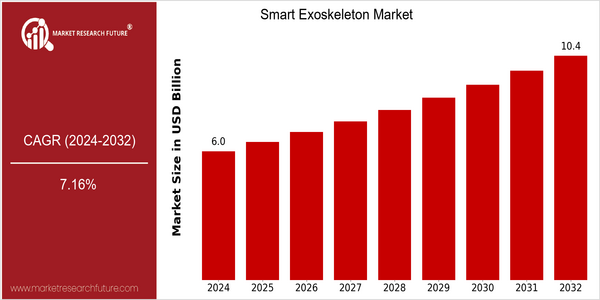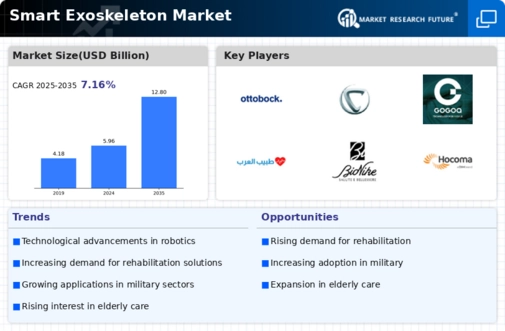Smart Exoskeleton Size
Market Size Snapshot
| Year | Value |
|---|---|
| 2024 | USD 5.9618 Billion |
| 2032 | USD 10.366 Billion |
| CAGR (2024-2032) | 7.16 % |
Note – Market size depicts the revenue generated over the financial year
The Smart Exoskeleton Market is set to witness a momentous growth with a market size of $ 5.96 billion in 2024, to reach $ 10.366 billion by 2032. This growth trajectory depicts a CAGR of 7.16 per cent during the forecast period. The increasing demand for advanced rehabilitation solutions, coupled with the rising prevalence of mobility impairments, is driving the demand for smart exoskeletons across various sectors, including military, medical, and industrial. The integration of artificial intelligence and machine learning in exoskeletons is further enhancing their functionality and the end-user experience. Strategic investments and collaborations between key players, such as Ekso Bionics, ReWalk, and Hyundai, are expected to further propel the market growth. Moreover, the increasing collaborations between tech players and the medical sector are paving the way for the development of intuitive and advanced exoskeletons. The focus on improving the patient outcomes and enhancing the productivity of the workforce will continue to shape the smart exoskeleton market.

Regional Market Size
Regional Deep Dive
The smart exoskeleton market is experiencing a steady growth across the globe, owing to the technological advancements, growing demand for rehabilitation, and the growing elderly population. Each region has its own characteristics, such as regulatory environment, cultural attitudes towards technology, and economic conditions. The smart exoskeletons market is expected to evolve with new designs and functionality. As the market evolves, the scope of applications will increase in the health care, defense, and manufacturing industries.
Europe
- The European Union has launched several funding initiatives aimed at supporting research and development in robotics and exoskeleton technologies, with projects like the 'ExoSkeletons for the Elderly' program gaining traction.
- Countries like Germany and France are witnessing a surge in partnerships between universities and tech companies, focusing on creating exoskeletons that cater to rehabilitation and mobility assistance for the elderly and disabled.
Asia Pacific
- Japan is at the forefront of exoskeleton development, with companies like Cyberdyne and Panasonic innovating in the field, particularly for elderly care and industrial applications.
- Government initiatives in South Korea, such as the 'Robot Industry Development Plan,' are promoting the integration of exoskeletons in various sectors, including manufacturing and healthcare, to enhance productivity and support aging workers.
Latin America
- Brazil is emerging as a hub for exoskeleton research, with universities collaborating with tech firms to develop affordable solutions for rehabilitation, particularly for stroke patients.
- Regulatory frameworks in countries like Mexico are evolving to accommodate new medical technologies, which is expected to facilitate the entry of innovative exoskeleton products into the market.
North America
- The U.S. Department of Defense has been actively investing in exoskeleton technology for military applications, with companies like Lockheed Martin and Sarcos Robotics leading the charge in developing advanced systems for soldiers.
- Recent regulatory changes by the FDA have streamlined the approval process for medical exoskeletons, encouraging more startups and established companies to enter the market, thus fostering innovation and competition.
Middle East And Africa
- In the UAE, the government is investing in smart technologies, including exoskeletons, as part of its broader strategy to enhance healthcare services and support rehabilitation for injured workers.
- South Africa is seeing a rise in local startups focusing on affordable exoskeleton solutions for rehabilitation, driven by a need to address the high rates of disability and injury in the region.
Did You Know?
“The first commercial exoskeleton was introduced in 2010, and since then, the technology has evolved significantly, with applications now spanning healthcare, military, and industrial sectors.” — International Federation of Robotics
Segmental Market Size
The market for smart exoskeletons is experiencing rapid growth. This is driven by advancements in robotics and an increasing demand for rehabilitation solutions. Among the main factors driving this market are the rising prevalence of mobility impairments and the need for improved safety in the workplace. In addition, companies are increasingly looking to reduce the number of accidents and increase productivity by using rehabilitation and safety solutions. At present, smart exoskeletons are in varying stages of commercialization, with many applications still in the pilot phase, especially in the medical and industrial fields. Companies such as Ekso Bionics and ReWalk are leading the way, with successful deployments in rehabilitation centres and construction sites. The most common applications are in the rehabilitation of stroke patients and the assistance of workers with heavy lifting. A growing elderly population and an increased focus on workplace ergonomics are driving this market. Meanwhile, technological developments such as artificial intelligence and machine learning are increasing the smart exoskeletons’ functionality and adaptability, thereby making them more effective and easier to use.
Future Outlook
The Smart Exoskeletons Market is expected to experience significant growth from 2024 to 2032, from an estimated $ 5.9 billion to $10.4 billion, at a CAGR of 7.16%. The growth is driven by the increasing demand for rehabilitation solutions in the health sector, the advancement of robots and artificial intelligence, and the growing focus on improving worker safety and increasing productivity in various industries. The penetration of smart exoskeletons in the rehabilitation market is expected to reach 15% by 2032 and in the industrial workforce is expected to reach 10% by 2032. The key technological drivers, such as the integration of machine learning and the development of sensors, will increase the functionality and adaptability of smart exoskeletons, thereby enhancing their attractiveness to consumers and businesses. The government's support for the development of assistive devices and the enforcement of occupational health and safety regulations will also promote market growth. The development of lightweight materials and the customisation of smart exoskeletons for specific applications will also play a key role in shaping the market landscape. As the industry develops, it is important for technology developers, health care professionals and regulatory authorities to work together to overcome the challenges and optimize the potential of smart exoskeletons in various fields.











Leave a Comment